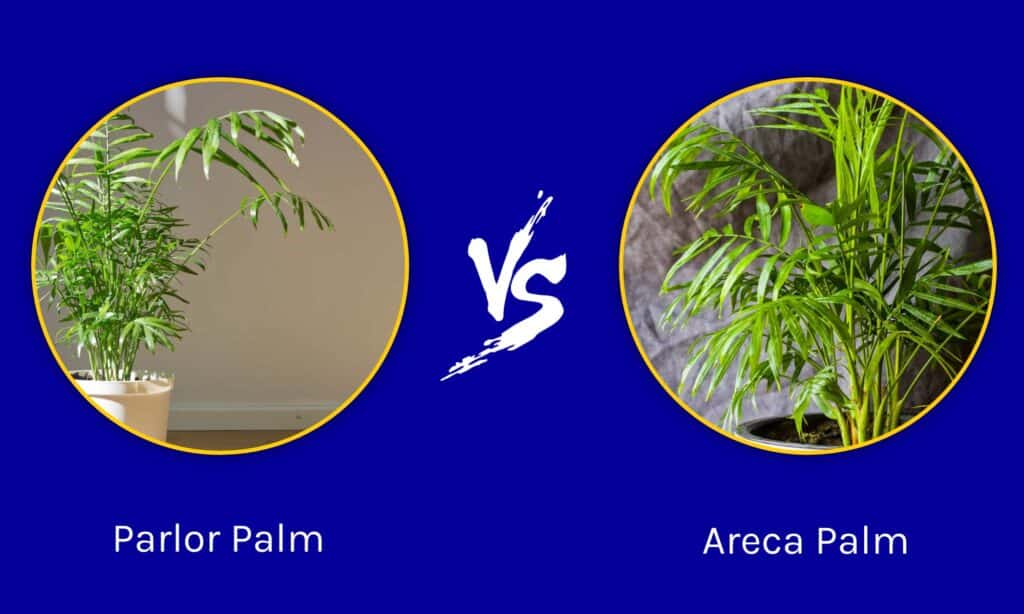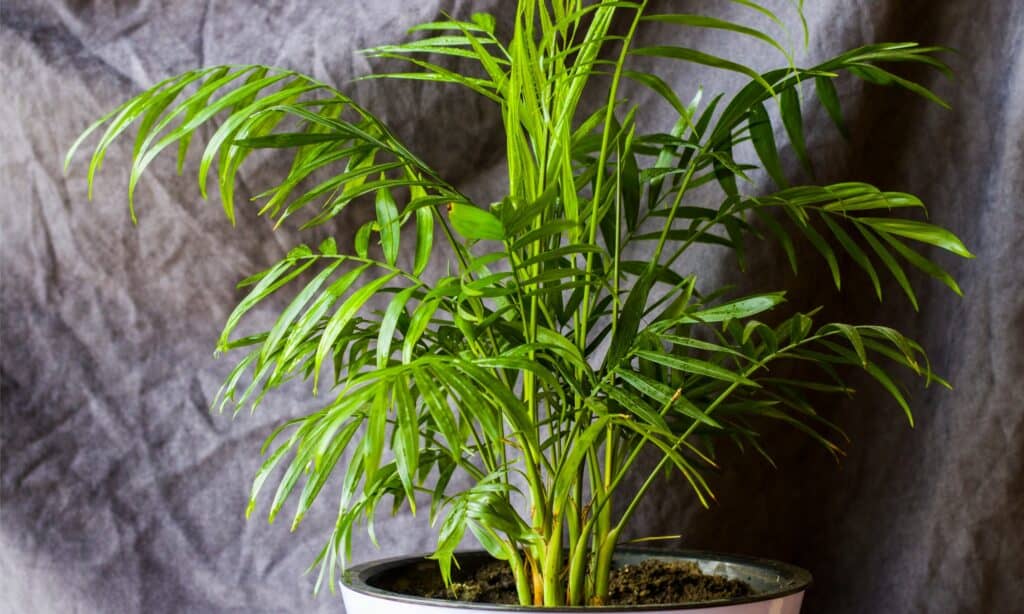While it may not look like it upon first glance, there are a number of differences between a parlor palm vs areca palm. But what might some of those differences be, and how can you learn how to tell these two popular indoor plants apart? If you are shopping around for a palm variety to keep in your own home, you’re in the right place.
In this article, we will compare and contrast the parlor palm with the areca palm so that you can fully understand both plants. We will address what they look like physically as well as where they grow best and where they originated from. Let’s get started and talk all about these two palm varieties now!
Comparing Parlor Palm vs Areca Palm

| Parlor Palm | Areca Palm | |
|---|---|---|
| Classification | Chamaedorea elegans | Dypsis lutescens |
| Description | A small, clumped palm with multiple fronds and clustered stalks. Covered in intricately textured leaves in an attractive green shade. Grows much smaller indoors versus outdoors, only reaching 6 ft tall inside. Looks more like a shrub than a tree, especially when grown in a container | Resembles bamboo in color and the way that it grows, with ribbon-like leaves and trunks that can turn golden yellow in color. When grown indoors, this palm can reach 8 ft tall, but grows much larger outside. Leaves spread wide and tall, with multiple clusters growing side by side |
| Uses | A popular indoor plant for beginning gardeners, given its ease of care. | Moderate growth rate is above average for other palm species, and it makes a great privacy plant when grown outside. |
| Origin and Growing Preferences | Originally found in Central America; enjoys indirect, filtered light and even watering. Take care to not overwater! | Originally found in Madagascar; enjoys direct, bright light to some shade. Make sure to not overwater, and filtered water or rainwater is preferred! |
| Special Features and Fun Facts | Popularly used in wreaths and decorations, given the fact that trimmings can survive at least a month on their own! | Technically endangered in Madagascar, but grown in many locations in the United States! |
Key Differences Between Parlor Palm vs Areca Palm

You may notice that the areca palm grows similarly to bamboo, while parlor palms have a more centralized trunk with compact shoots.
©iStock.com/Tamar Dundua
There are a number of key differences between the parlor palm and the areca palm. For example, the parlor palm is a much smaller palm variety compared to the areca palm. In addition, areca palm trees grow similarly to bamboo, while parlor palm trees have a more centralized trunk. Finally, parlor palm fronds are smaller and more delicate compared to the fronds of the areca palm.
Let’s go over all of these differences in more detail now.
Parlor Palm vs Areca Palm: Classification
Both from the Arecaceae family, there are some undeniable similarities between the parlor palm and the areca palm. However, these two trees are from different species- the parlor palm is classified as Chamaedorea, while the areca palm is classified as Dypsis. This leads to their physical differences from one another, which we will discuss now.
Parlor Palm vs Areca Palm: Description

Besides the leaves and trunks, the areca palm grows much taller than the parlor palm, both indoors and outdoors.
©iStock.com/ELENA PETRUNEVA
It can be incredibly difficult to tell the difference between the parlor palm and the areca palm unless you are comparing them side by side. For example, you may notice that the areca palm grows similarly to bamboo, while parlor palms have a more centralized trunk with compact shoots. In addition, the parlor palm appears more elegant compared to the simple areca palm. For lack of a better descriptor, just remember that the parlor palm is scientifically classified as elegans!
Besides the leaves and trunks, the areca palm grows much taller than the parlor palm, both indoors and outdoors. The parlor palm looks more like a shrub compared to a palm tree when grown in a container, while the areca palm looks more like a tree, even indoors. Finally, the trunk of the areca palm is often yellowish in color, while the trunk of the parlor palm remains green.
Parlor Palm vs Areca Palm: Uses

The parlor palm is one of the most popular indoor palms in the world, while the areca palm isn’t as popular.
©iStock.com/dropStock
Parlor palms and areca palms are used in similar ways, but there are some ways in which they differ. For example, the parlor palm is one of the most popular indoor palms in the world, while the areca palm isn’t as popular. In addition, while both make ideal indoor plants, the areca palm makes a great outdoor plant, especially if you are seeking something that offers your privacy.
Parlor Palm vs Areca Palm: Origin and How to Grow
There are some differences in the origin of the parlor palm and the areca palm. For example, the areca palm originated in Madagascar, while the parlor palm originated in Central America. Both of these palms prefer evenly moist, well-draining soil, though the areca palm is sensitive to unfiltered water. In addition, the areca palm can handle full sun to partial shade, while the parlor palm prefers indirect and filtered light.
Parlor Palm vs Areca Palm: Special Features

The areca palm originated in Madagascar, while the parlor palm originated in Central America.
©iStock.com/Wheatfield
Both the parlor palm and the areca palm are great indoor plants, for a number of reasons. When it comes to indoor decorating, parlor palm fronds are ideal when trimmed, as you can use these fronds for at least a month before they start to die! The areca palm remains popular throughout the United States and is grown outdoors in many locations. But you may not know that the areca palm is actually endangered where it originated: in Madagascar!
The photo featured at the top of this post is © iStock.com/Tamar Dundua
Thank you for reading! Have some feedback for us? Contact the AZ Animals editorial team.






